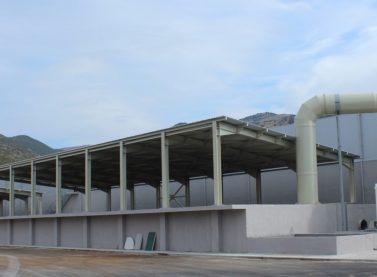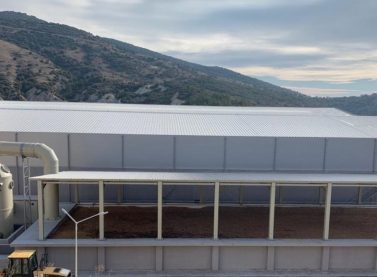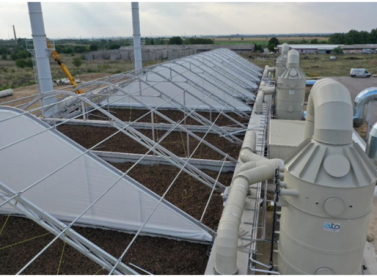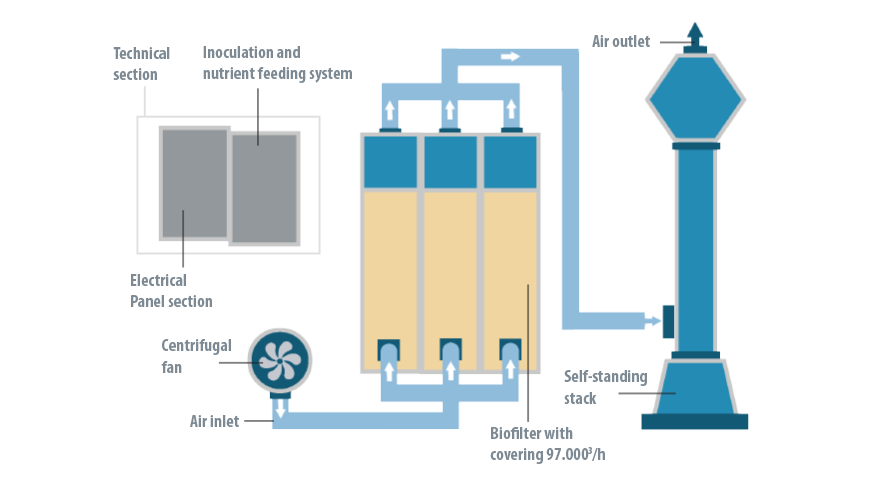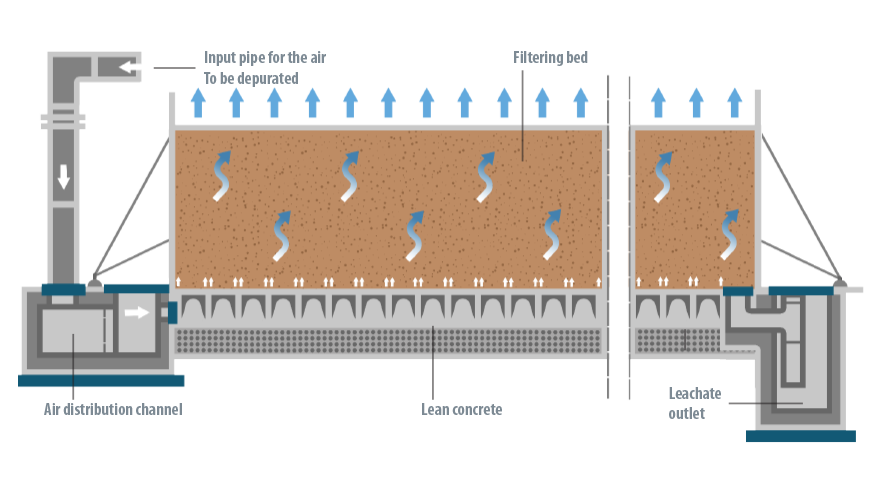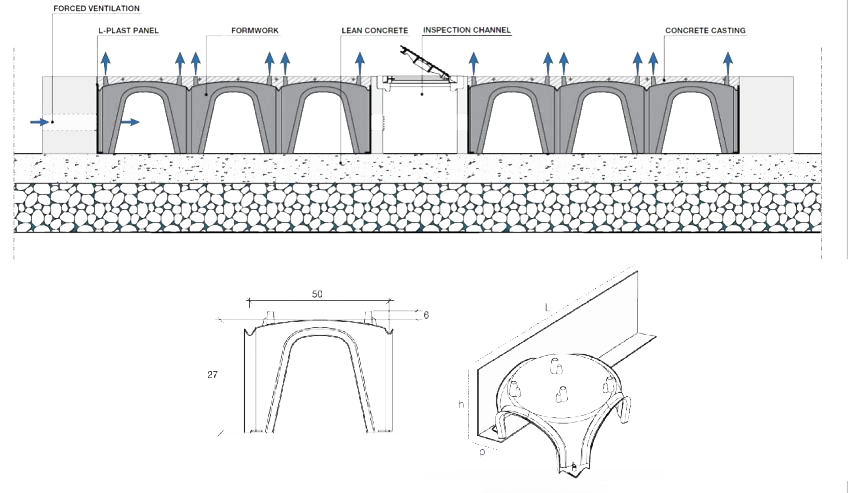Our biofilters for VOC and odor removal
Condorchem Envitech designs and manufactures biofilters for air pollution control. Air biofilters are a very efficient technology for the removal of odours and volatile organic compounds.
Biofiltration is a biological process used for the treatment of VOCs and inorganic compounds. Microorganisms are used for its application, subjecting the pollutants contained in the air to biological degradation. Biofilters are also one of the most widely-used technologies for odour treatment, due to their excellent effectiveness and their ease of use and maintenance.
There are different types of biofilters, with the most common being as follows:
- Biofilters with a concrete structure
- Biofilters with a sandwich panel structure
- Biofilters with a stainless steel structure
The operating principle of biofilters is based on the oxidation of polluting substances by the bacteria that live in the "biofilm", which are fed by the organic substances present in the air.
The air that enters the biofilter passes from the bottom to the top of the filter bed, which is composed of an organic base with a layer of "biofilm" containing the microorganisms that metabolise the pollutants in the air that is being treated.
The optimal environment for bacterial activity is maintained by regular and controlled irrigation, which ensures the effectiveness of the process.
Our air biofilters
Technical characteristics
- Very large volume of air treated (from 500 Nm3/hour to > 200,000 Nm3/hour)
- Highly efficient odour treatment (>95%)
- Automatic operation via a PLC and HMI screen
- Manufactured with: concrete or self-standing panels
- Filled with synthetic or organic material
| Flow rate (m3/h) | Surface area | Installed power (kW) |
| 1.000 | 7 m2 x H 2 m | 1,5 |
| 5.000 | 35 m2 x H 2 m | 7,5 |
| 10.000 | 70 m2 x H 2 m | 15 |
| 20.000 | 140 m2 x H 2 m | 30 |
| 30.000 | 210 m2 x H 2 m | 37 |
| 40.000 | 280 m2 x H 2,3 m | 55 |
| 50.000 | 350 m2 x H 2,3 m | 75 |
| 60.000 | 420 m2 x H 2,3 m | 75 |
Components
- Structure (concrete or sandwich panels)
- Humidification and biological additive dosing system
- Filter media (wood pellets, pine bark or inorganic filler)
- Support grid or bio-modules to support the filter media
- Filter bed made of different specific materials
- Combination of specific microorganisms according to the substances being removed
- Moisture and temperature sensors
- Irrigation system with nozzles and feed valve
- Recirculation pumps
- Scrubbing ramp
- Electrical panel
- Process fan (optional)
- Antifreeze system for the irrigation system (optional)
- Biofilter cover (optional)
- Pre-biofilter scrubber (optional)
Benefits of biofilters
- Highly adaptable to variations in pollutants.
- Can treat fine particles and low concentrations of ammonia.
- Produces no liquid effluents or by-products.
- Systems that are easy to build and install.
- Low investment and operating cost.
Applications
- General industrial odour treatment
- Metallurgical industry
- Landfills and municipal solid waste (MSW) plants
- RDF (refuse derived fuel) industry
- Composting plants
- Municipal wastewater treatment plants
Biofilter operation
The contaminated air enters through the lower part of the filtering pool where it is evenly distributed throughout the filtering surface. The air rises upwards, passing through the porous filter media, to which the microorganisms are attached.
The pollutants pass from the gas phase to the liquid phase, where they are used by the biomass as food (source of carbon). The clean gas is released directly into the atmosphere through the top part.
The filter must be kept humidified by sprinklers in the upper part. It is recommended to have a rain cover and a condensate drain system at the bottom of the pool.
The tower has two openings for inspecting and cleaning its internal parts. The tower is connected to a fan (this may be a blower or vacuum fan) to rectify any drop in pressure in the tower.
It is advisable to perform a chemical pre-wash of the biofilter inlet to prevent any toxic compounds that could remove or inhibit the biomass. These systems usually come with an acid gas scrubber at the inlet.
Introduction to biofilters
Biofiltration is a biological process used for the treatment of volatile organic compounds and inorganic compounds. Microorganisms are used for its application, subjecting the pollutants contained in the air to biological degradation.
During a biofiltration air treatment process, the contaminated air passes through the filter media's macropores. The pollutants are then degraded and subsequently transferred to a liquid medium, where they are used as a source of carbon and energy (organic compounds) or a source of energy (inorganic compounds).
It is a highly adaptable and safe system, highly efficient in the treatment of odorous emissions. The filter media need to be emptied out and replaced periodically (every 4-6 years). It is recommended to install a protective cover.
Its use involves the production of biomass and the partial or full oxidation of the pollutant. In turn, under certain conditions, the biomass is oxidised through endogenous respiration. As a result, biofiltration processes lead to the complete decomposition of the pollutants without creating hazardous by-products.
There are three types of biofilter:
Fixed-bed biofilters consist of a filter medium that can either be synthetic or organic, which serves as a support for the microorganisms. Porous rocks, diatomaceous earth, perlite, soil, pieces of wood and different types of compost or organic waste can be used as filter media. They work by passing the moisture-saturated gas stream containing the pollutant through the bed where the pollutants are broken down by microorganisms. Suitable for treating pollutants that are highly insoluble in water due to the lack of aqueous phase. It is worth noting that the footprint of FBBs is greater than that of other types of biofilters.
Trickle-bed biofilters consist of a packed column with an inert support where the biofilm develops. A gas stream containing the substrate that is to be biodegraded is fed through the bed along with a liquid stream that is typically recirculated through the bed and which serves the function of providing essential nutrients for the biofilm and removing the microorganisms’ degradation products. These systems are recommended for water-soluble compounds. Recirculating the liquid makes it easier to remove the reaction products and ensures greater control over the biological process by controlling the pH and the liquid medium composition. These systems have a smaller footprint and they are easy to operate.
In bioscrubbers the compound being degraded is first absorbed in the liquid phase located in a liquid-filled absorption tower. The process consists of making the gas flow counter-current to the liquid, where contaminants and O2 are absorbed. Subsequently, the liquid is fed to a reactor packed with an inert material covered with a biofilm which degrades the pollutant. Bioscrubbers are suitable systems for treating compounds that are highly water-soluble.
Their advantage over biofilters is that they do not accumulate products that may have harmful effects on the microorganisms and the ease of controlling the biological process through the composition of the liquid medium.
However, they are more costly as they require two pieces of equipment, one for absorption and the other for the biodegradation of the pollutant, which make them more expensive than trickle-bed biofilters.
Choosing the most suitable system depends on the characteristics of the gas stream being treated, the expected removal efficiency and the costs involved.
The main parameters to be considered when designing a biofiltration system are:
1. The characteristics of the polluting gas (concentration, flow rate, presence of particles, temperature).
2. Selecting the filter medium.
3. Moisture content of the filter medium.
4. Microorganisms.
Biofilters with grids and perforated concrete
Plastic grids are an efficient, quick and inexpensive solution when building a perforated reinforced concrete floor with a high load-bearing capacity, which can also be accessed by heavy vehicles. Thanks to the axially perforated vertical asymmetric nozzles, this system can be used highly effectively for air distribution in composting processes, waste stabilisation systems, or deodorising systems.
Benefits:
- Efficient ventilation in all directions thanks to the cavity created in the formwork.
- The structure has a high load-bearing capacity, both for the static loads of the filter media and the movement of heavy vehicles.
- Simple installation thanks to their light weight and modules that are easy to attach.
- Maintenance/cleaning possible via the inspection channels.
- Collection of any leachates.
Each module is made of recycled plastic and composed of high nozzles that allow a 6 cm-high perforated plate to be installed. Through these nozzles, the air is distributed evenly in the air cavity and then carried to the upper area.
This system can achieve the same results as combustion technologies although, unlike them, the oxidation of volatile organic compounds with carbon dioxide is biological rather than thermal. If the mixtures contain sulphur, nitrogen, or chlorine, the oxidation by-products are mineral salts.
In the case of biofilters with plastic grids, it is possible to design a perforated floor thanks to the nozzles, which enable an even and uniform distribution of the air. Through the air cavity created by the plastic grids and their output nozzles, the air is distributed evenly across the whole surface of the filter bed.
Biofiltration is a technology used to reduce pollutants present in the air using biological oxidation. During the biofiltration process, the contaminated air is carried through a medium containing microorganisms that are capable of breaking down polluting substances, using them as a source of nutrition.
Biofiltration is a cheaper solution than combustion systems, both in terms of construction and maintenance, but a well-designed plant is essential to achieve optimal results.
| Dimensions | Amount of concrete | Weight per unit | Nozzle height | Units per pallet | Panel L - h | Panel L - L | Panel L - p |
| 50x50x50 cm | 0.04 m3/m2 | 1.990 kg | 6 cm | 220 | 25 cm | 205 cm | 7 cm |
